Abstract
The active centre of the semi-synthetic enzyme thiolsubtilisin was investigated by studying the kinetics of the reaction of the thiol group of cysteine-221 with the thiol-specific two-protonic-state reactivity probe 2,2'-dipyridyl disulphide. The three-states criterion [Brocklehurst (1974) Tetrahedron 30, 2397-2407] was used to provide definitive evidence of the existence of a thiol--imidazole interactive system in acidic media in which the sulphur atom possesses highly nucleophilic character. The lack of catalytic competence of thiolsubtilisin despite its possession of the requisite nucleophilic capability is discussed. The exceedingly high rate of reaction of thiolsubtilisin with 2,2'-dipyridyl disulphide at pH 4--5 is shown to constitute a rapid and convenient active-site titration in which intact thiol--imidazole interaction is detected even in the presence of other thiols.
Full text
PDF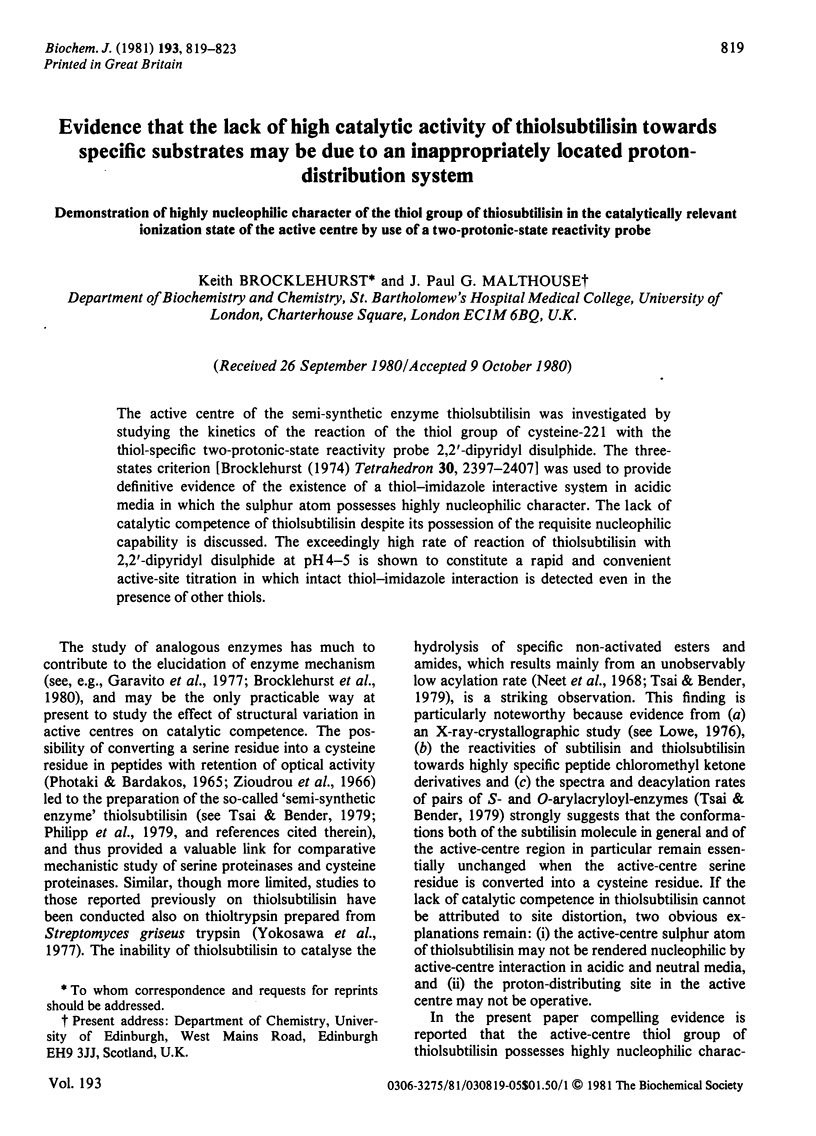
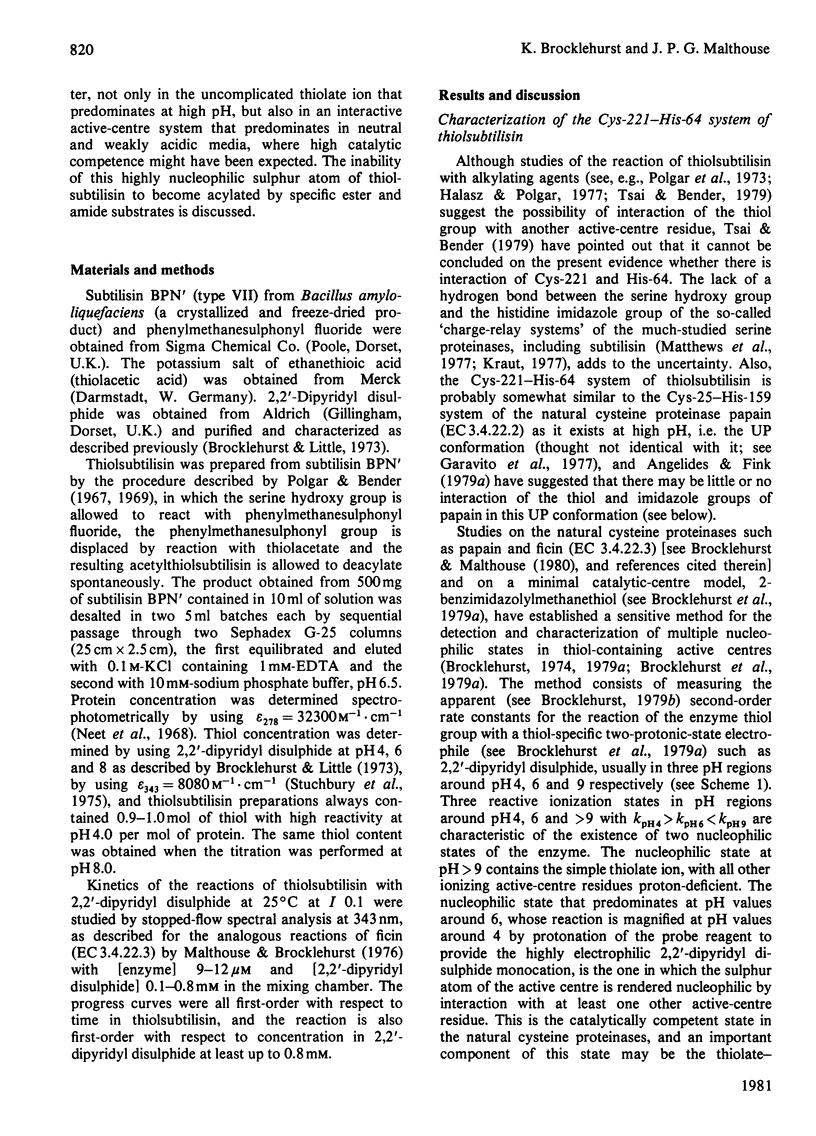
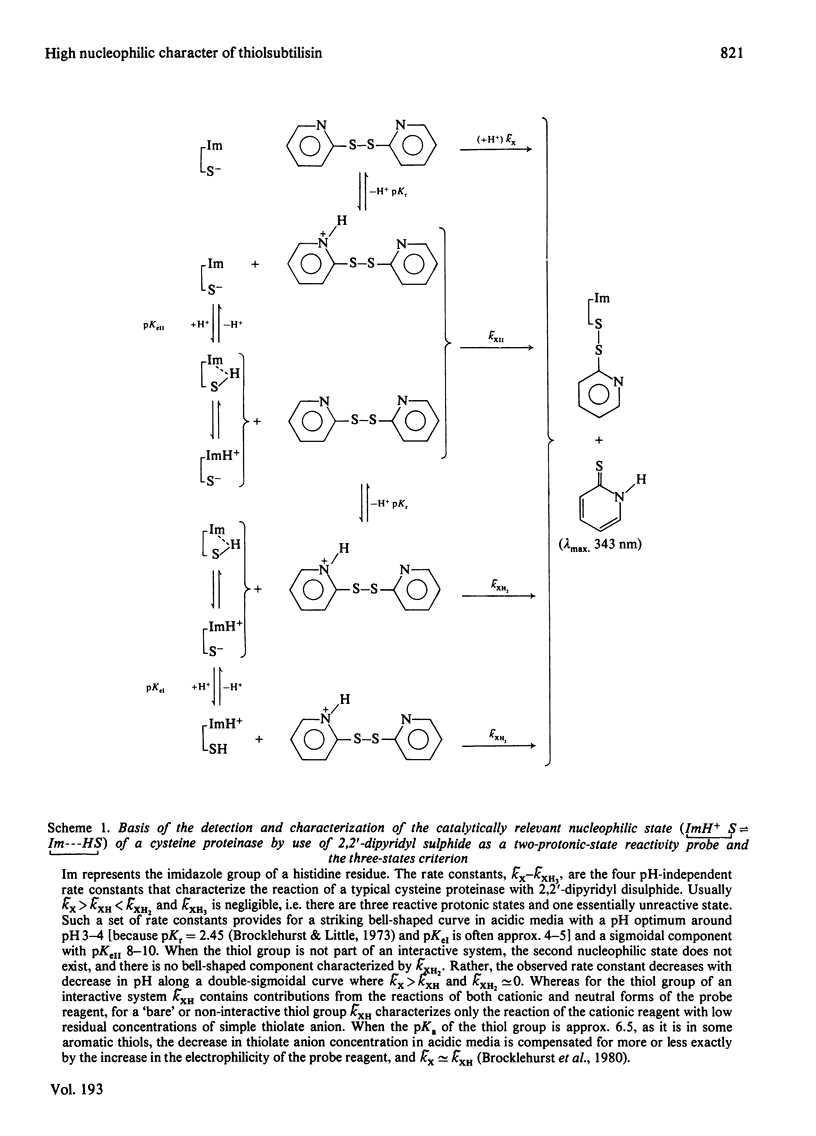
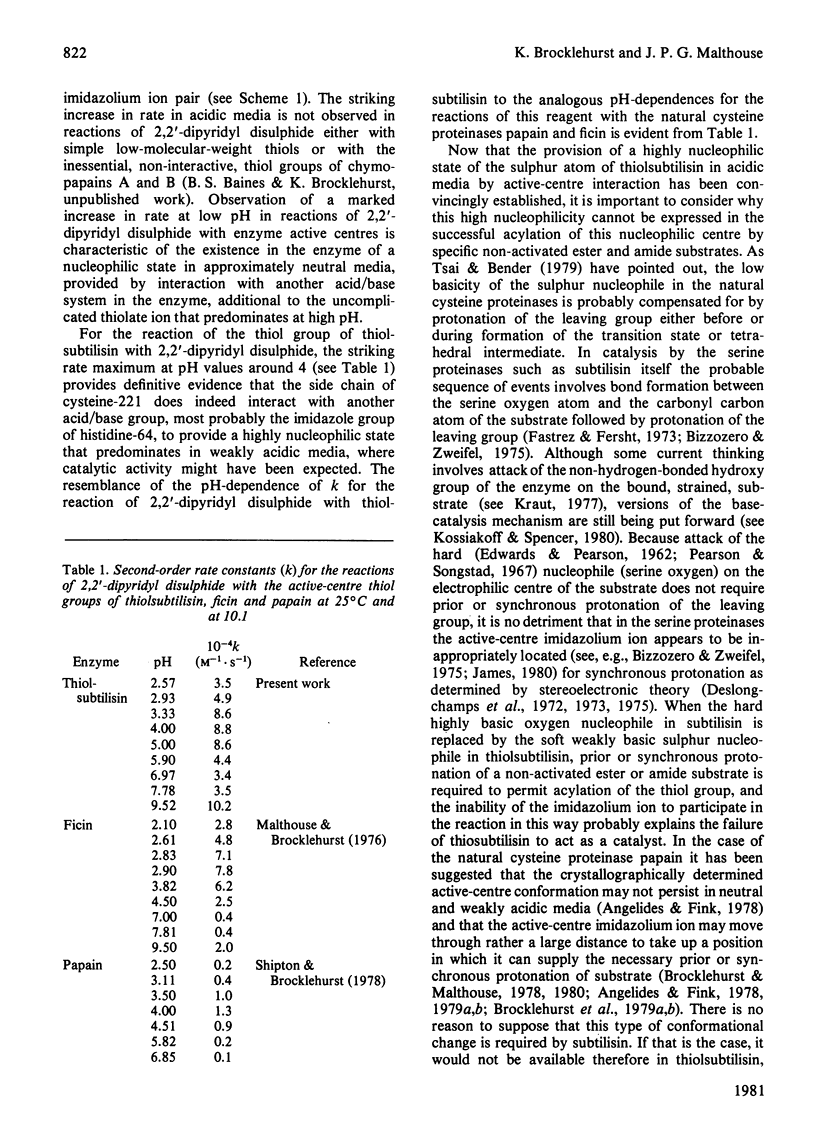
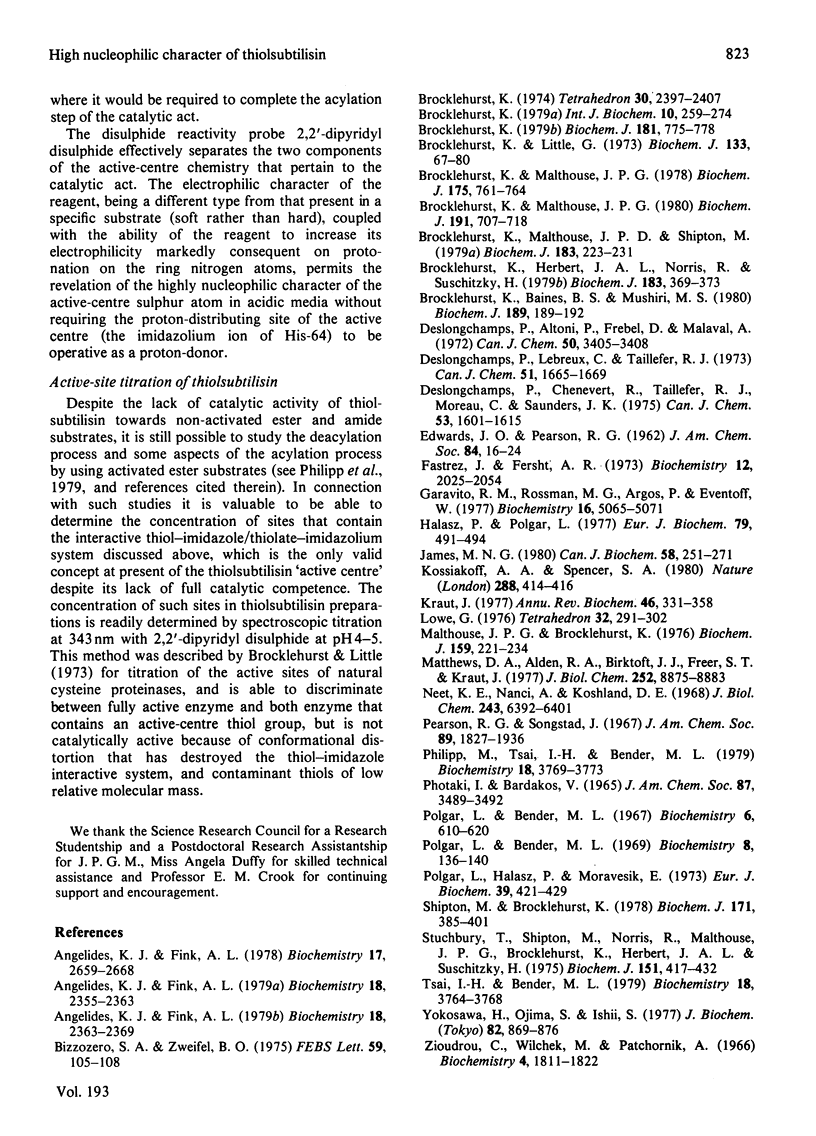
Selected References
These references are in PubMed. This may not be the complete list of references from this article.
- Angelides K. J., Fink A. L. Cryoenzymology of papain: reaction mechanism with an ester substrate. Biochemistry. 1978 Jun 27;17(13):2659–2668. doi: 10.1021/bi00606a032. [DOI] [PubMed] [Google Scholar]
- Angelides K. J., Fink A. L. Mechanism of Action of papain with a specific anilide substrate. Biochemistry. 1979 May 29;18(11):2355–2363. doi: 10.1021/bi00578a034. [DOI] [PubMed] [Google Scholar]
- Angelides K. J., Fink A. L. Mechanism of thiol protease catalysis: detection and stabilization of a tetrahedral intermediate in papain catalysis. Biochemistry. 1979 May 29;18(11):2363–2369. doi: 10.1021/bi00578a035. [DOI] [PubMed] [Google Scholar]
- Bizzozero S. A., Zweifel B. O. The importance of the conformation of the tetrahedral intermediate for the alpha-chymotrypsin-catalyzed hydrolysis of peptide substrates. FEBS Lett. 1975 Nov 1;59(1):105–108. doi: 10.1016/0014-5793(75)80351-6. [DOI] [PubMed] [Google Scholar]
- Brocklehurst K., Baines B. S., Mushiri M. S. Evidence that the active centre of chymopapain A is different from the active centres of some other cysteine proteinases and that the Brønsted coefficient (beta nuc.) for the reactions of thiolate anions with 2,2'-dipyridyl disulphide may be decreased by reagent protonation. Biochem J. 1980 Jul 1;189(1):189–129. doi: 10.1042/bj1890189. [DOI] [PMC free article] [PubMed] [Google Scholar]
- Brocklehurst K., Herbert J. A., Norris R., Suschitzky H. Evidence for association-activation effects in reactions of papain from studies on its reactivity towards isomeric two-protonic-state reactivity probes. Biochem J. 1979 Nov 1;183(2):369–373. doi: 10.1042/bj1830369. [DOI] [PMC free article] [PubMed] [Google Scholar]
- Brocklehurst K., Little G. Reactions of papain and of low-molecular-weight thiols with some aromatic disulphides. 2,2'-Dipyridyl disulphide as a convenient active-site titrant for papain even in the presence of other thiols. Biochem J. 1973 May;133(1):67–80. doi: 10.1042/bj1330067. [DOI] [PMC free article] [PubMed] [Google Scholar]
- Brocklehurst K., Malthouse J. P. Evidence for a two-state transition in papain that may have no close analogue in ficin. Differences in the disposition of cationic sites and hydrophobic binding areas in the active centres of papain and ficin. Biochem J. 1980 Dec 1;191(3):707–718. doi: 10.1042/bj1910707. [DOI] [PMC free article] [PubMed] [Google Scholar]
- Brocklehurst K., Malthouse J. P. Mechanism of the reaction of papain with substrate-derived diazomethyl ketones. Implications for the difference in site specificity of halomethyl ketones for serine proteinases and cysteine proteinases and for stereoelectronic requirements in the papain catalytic mechanism. Biochem J. 1978 Nov 1;175(2):761–764. doi: 10.1042/bj1750761. [DOI] [PMC free article] [PubMed] [Google Scholar]
- Brocklehurst K., Malthouse J. P., Shipton M. Evidence that binding to the s2-subsite of papain may be coupled with catalytically relevant structural change involving the cysteine-25-histidine-159 diad. Kinetics of the reaction of papain with a two-protonic-state reactivity probe containing a hydrophobic side chain. Biochem J. 1979 Nov 1;183(2):223–231. doi: 10.1042/bj1830223. [DOI] [PMC free article] [PubMed] [Google Scholar]
- Brocklehurst K. Specific covalent modification of thiols: applications in the study of enzymes and other biomolecules. Int J Biochem. 1979;10(4):259–274. doi: 10.1016/0020-711x(79)90088-0. [DOI] [PubMed] [Google Scholar]
- Brocklehurst K. The equilibrium assumption is valid for the kinetic treatment of most time-dependent protein-modification reactions. Biochem J. 1979 Sep 1;181(3):775–778. doi: 10.1042/bj1810775. [DOI] [PMC free article] [PubMed] [Google Scholar]
- Fastrez J., Fersht A. R. Demonstration of the acyl-enzyme mechanism for the hydrolysis of peptides and anilides by chymotrypsin. Biochemistry. 1973 May 22;12(11):2025–2034. doi: 10.1021/bi00735a001. [DOI] [PubMed] [Google Scholar]
- Garavito R. M., Rossmann M. G., Argos P., Eventoff W. Convergence of active center geometries. Biochemistry. 1977 Nov 15;16(23):5065–5071. doi: 10.1021/bi00642a019. [DOI] [PubMed] [Google Scholar]
- Halász P., Polgár L. Negatively charged reactants as probes in the study of the essential mercaptide-imidazolium ion-pair of thiolenzymes. Eur J Biochem. 1977 Oct 3;79(2):491–494. doi: 10.1111/j.1432-1033.1977.tb11832.x. [DOI] [PubMed] [Google Scholar]
- Kossiakoff A. A., Spencer S. A. Neutron diffraction identifies His 57 as the catalytic base in trypsin. Nature. 1980 Nov 27;288(5789):414–416. doi: 10.1038/288414a0. [DOI] [PubMed] [Google Scholar]
- Kraut J. Serine proteases: structure and mechanism of catalysis. Annu Rev Biochem. 1977;46:331–358. doi: 10.1146/annurev.bi.46.070177.001555. [DOI] [PubMed] [Google Scholar]
- Malthouse J. P., Brocklehurst K. Preparation of fully active ficin from Ficus glabrata by covalent chromatography and characterization of its active centre by using 2,2'-depyridyl disulphide as a reactivity probe. Biochem J. 1976 Nov;159(2):221–234. doi: 10.1042/bj1590221. [DOI] [PMC free article] [PubMed] [Google Scholar]
- Matthews D. A., Alden R. A., Birktoft J. J., Freer T., Kraut J. Re-examination of the charge relay system in subtilisin comparison with other serine proteases. J Biol Chem. 1977 Dec 25;252(24):8875–8883. [PubMed] [Google Scholar]
- Neet K. E., Nanci A., Koshland D. E., Jr Properties of thiol-subtilisin. The consequences of converting the active serine residue to cysteine in a serine protease. J Biol Chem. 1968 Dec 25;243(24):6392–6401. [PubMed] [Google Scholar]
- PHOTAKI I., BARDAKOS V. TRANSFORMATION OF L-SERINE PEPTIDES TO L-CYSTEINE PEPTIDES. J Am Chem Soc. 1965 Aug 5;87:3489–3492. doi: 10.1021/ja01093a037. [DOI] [PubMed] [Google Scholar]
- Philipp M., Tsai I. H., Bender M. L. Comparison of the kinetic specificity of subtilisin and thiolsubtilisin toward n-alkyl p-nitrophenyl esters. Biochemistry. 1979 Aug 21;18(17):3769–3773. doi: 10.1021/bi00584a020. [DOI] [PubMed] [Google Scholar]
- Polgar L., Bender M. L. Chromatography and activity of thiol-subtilisin. Biochemistry. 1969 Jan;8(1):136–141. doi: 10.1021/bi00829a019. [DOI] [PubMed] [Google Scholar]
- Polgar L., Bender M. L. The reactivity of thiol-subtilisin, an enzyme containing a synthetic functional group. Biochemistry. 1967 Feb;6(2):610–620. doi: 10.1021/bi00854a032. [DOI] [PubMed] [Google Scholar]
- Polgár L., Halász P. On the reactivity of the thiol group of thiolsubtilisin. Eur J Biochem. 1973 Nov 15;39(2):421–429. doi: 10.1111/j.1432-1033.1973.tb03140.x. [DOI] [PubMed] [Google Scholar]
- Shipton M., Brochlehurst K. Characterization of the papain active centre by using two-protonic-state electrophiles as reactivity probes. Evidence for nucleophilic reactivity in the un-interrupted cysteine-25-histidine-159 interactive system. Biochem J. 1978 May 1;171(2):385–401. doi: 10.1042/bj1710385. [DOI] [PMC free article] [PubMed] [Google Scholar]
- Tsai I. H., Bender M. L. Conformation of the active site of thiolsubtilisin: reaction with specific chloromethyl ketones and arylacryloylimidazoles. Biochemistry. 1979 Aug 21;18(17):3764–3768. doi: 10.1021/bi00584a019. [DOI] [PubMed] [Google Scholar]
- Yokosawa H., Ojima S., Ishii S. Thioltrypsin. Chemical transformation of the active-site serine residue of Streptomyces griseus trypsin to a cysteine residue. J Biochem. 1977 Sep;82(3):869–876. doi: 10.1093/oxfordjournals.jbchem.a131763. [DOI] [PubMed] [Google Scholar]


